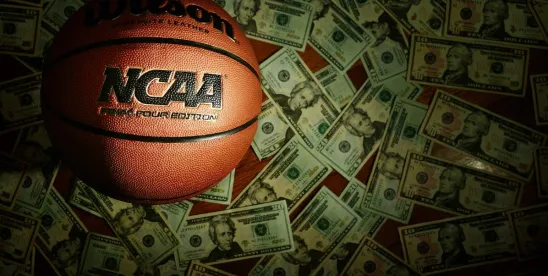In a landmark decision, the U.S. Court of Appeals for the Third Circuit rejected the NCAA’s argument that, because student-athletes voluntarily participate in college athletics, they cannot simultaneously be students and employees under the Fair Labor Standards Act (FLSA).
In Johnson v. NCAA, the three-judge panel stymied the NCAA’s effort to reverse the denial of its motion to dismiss, (1) ruling that college athlete’s “amateur status” did not preclude them from bringing an FLSA claim and (2) setting out a new economics-based test for lower courts to apply when determining if college athletes are employees under the FLSA.
This decision creates a circuit split between the Third, Seventh, and Ninth Circuits, foreshadowing potential U.S. Supreme Court involvement.
History Leading Up to Johnson v. NCAA
The NCAA created the term “student-athlete,” to emphasize student-athlete’s status as “amateurs,” differentiating them from both professional athletes and traditional student workers. This argument was supported by the Supreme Court’s decision in NCAA v. Board of Regents of the University of Oklahoma, which upheld the tradition of amateurism in college sports. However, the Supreme Court recently clarified in NCAA v. Alston that this statement did not create a binding precedent endorsing the NCAA’s compensation rules.
Other circuits have also examined the economic realities of student-athletes’ relationships with their schools. In Berger v. NCAA, the Seventh Circuit relied on the “revered tradition of amateurism” to conclude that the FLSA did not apply to student-athletes, as their activities were “extracurricular’ and “interscholastic” in nature. Similarly, in Dawson v. NCAA, the Ninth Circuit held that student-athletes were not employees of the NCAA nor the PAC-12 Conference because the NCAA and PAC-12 were more akin to regulatory bodies, not employers.
Third Circuit Decision
Johnson v. NCAA began in 2019 at the U.S. District Court for the Eastern District of Pennsylvania, with current and former athletes from various Division I schools filing a lawsuit for back pay and damages for unjust enrichment due to their rendering of athletic services to their schools at games and practice.
After the NCAA appealed the denial of their motion to dismiss, the Third Circuit was asked to determine the critical question — whether NCAA athletes can be “employees of the colleges and universities they attend for purposes of the Fair Labor Standards Act solely by virtue of their participation in interscholastic athletics.” The NCAA argued that the “revered tradition of amateurism” should shield them from FLSA claims and noted that existing Department of Labor guidelines prohibit student-athletes from being able to be considered employees. Further, the NCAA argued that the “activity of college students participating in interscholastic athletics primarily for their own benefit as part of the educational opportunities provided to the students by the school is not ‘work.’” U.S. Department of Labor Field Operations Handbook § 10b03(e) (2016). The plaintiffs countered that they are employees of their schools because they satisfy the FLSA’s relevant test for employee status, as their performance in athletic activities indeed constituted “work.” This is largely due to the control that each school has over its athletes’ time and labor, and the separation and distinction between athletes’ athletic participation and their academic work.
In a departure from the district court’s reasoning, the Third Circuit unequivocally rejected the NCAA’s argument that the “frayed tradition” of amateurism shielded them from FLSA claims and determined that student-athletes can be employees under the FLSA. The Third Circuit focused on the economic relationship between the NCAA and student-athletes to determine that they could be employees under the FLSA. The Eastern District Court of Pennsylvania had relied on a test set out by the Second Circuit in Glatt v. Fox Searchlight Pictures, in which the Second Circuit applied a multifactor test to determine whether unpaid interns were employees under the FLSA. However, the Third Circuit held that while unpaid interns and student-athletes share similar considerations, unpaid interns are fundamentally different from college athletes due to their work type. Therefore, Glatt was not the proper test to determine whether college athletes qualify as employees under the FLSA.
The Third Circuit set a new test to determine college athletes’ status under the FLSA. College athletes may be employees under the FLSA if sufficient evidence establishes that the student-athletes:
- Perform services for another party;
- Necessarily and primarily for the other party’s benefit;
- Under their universities control or right of control; and
- In return for “express” or “implied” compensation or “in-kind benefits.”
An athlete that fits these criteria “may plainly fall within the meaning of ‘employee’ as defined in [the FLSA].” The Third Circuit directed the lower courts to focus on the cumulative circumstances of the relationship between the athlete and the college or NCAA and whether this relationship “reveal[s] an economic reality that is that of an employee-employer.”
Critically, the Third Circuit held that college athletes cannot be barred as a matter of law from asserting FLSA claims simply by the “revered tradition of amateurism” in college athletics. The Third Circuit criticized the NCAA’s argument as circular, citing Supreme Court Justice Brett Kavanaugh’s concurrence in Alston. “[T]he argument ‘that colleges may decline to pay student athletes because the defining feature of college sports . . . is that the student athletes are not paid,’ is circular, unpersuasive, and increasingly untrue.”
Thus, Johnson returns to Judge John Padova of the Eastern District Court of Pennsylvania to apply the new economic realities test.
Implications for Colleges and Universities
Johnson represents a growing change in the judicial understanding of student-athletes’ relationships with their institutions. Courts are increasingly focusing on the economic relationship between institutions and their students. Johnson will undoubtedly lead to college athletes in popular sports such as football and basketball attaining FLSA employee status.
Further, Johnson creates a circuit split between the Third Circuit and the Ninth and Seventh Circuits, which have already held that student-athletes are not employees under the FLSA.
Luis Moreno contributed to this article




 />i
/>i

